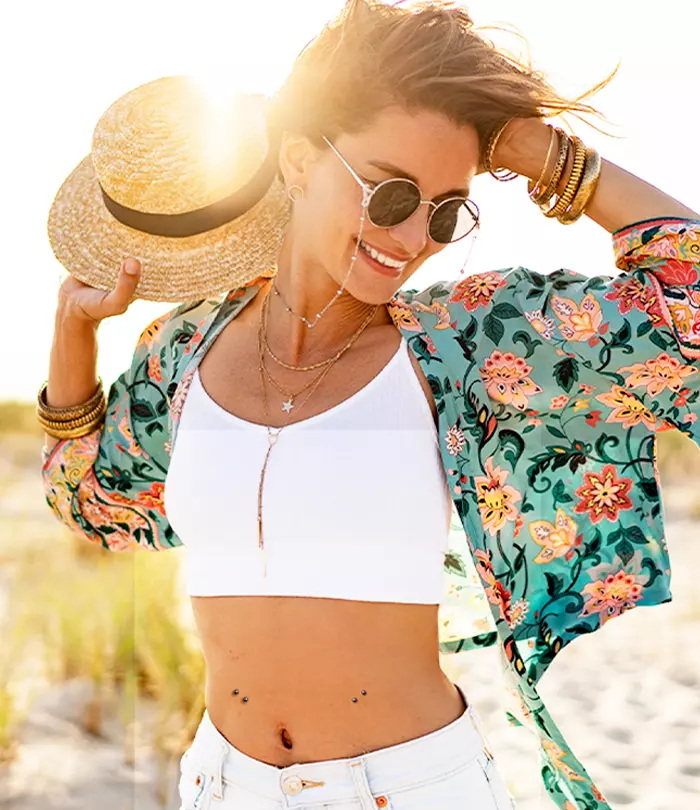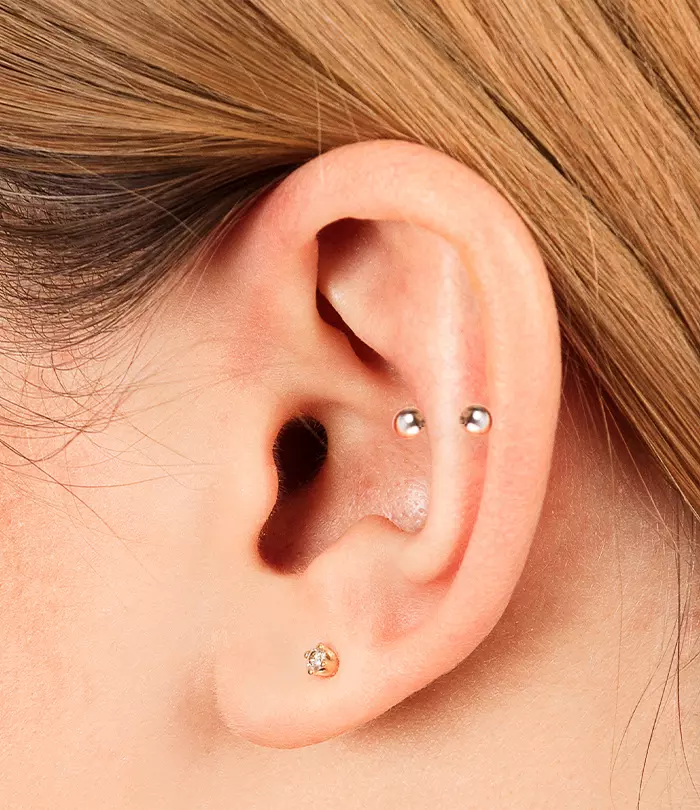Wrist Piercing: Types, Pain, Healing, And Aftercare
Elevate your style game with this bold and fashionable surface piercing.

Image: StyleCraze Design Team
If you are looking to adorn your body with some visible and shiny surface piercings, check out the novel trend of wrist piercings. In the pursuit of creating unique and stylish statements of self-expression, wrist piercings have emerged as an innovative solution that fits right in with accessorizing and tattooing the inner arm. From barbells and rings to eccentric studs, these piercings can carry a wide range of jewelry for stunning and insanely attractive arm ornaments. Stick around if you are taken by this new fashion statement, for in this article, we share in-depth details about this piercing, its types and process, and even comprehensive aftercare tips. This informative guide will help you decide if wrist piercings are really your thing. So, let us not dally, and dive right in!

 Piercing Guide: Wrist Piercing
Piercing Guide: Wrist Piercing- Placement: Wrists and slightly upward
- Best Jewelry: Surface barbells, studs, captive bead rings
- Cost: $50 to $100
- Pain Level: Medium
- Healing Time: 2 to 8 weeks
In This Article
What Is A Wrist Piercing?
View this post on Instagram
A wrist piercing is a surface piercing, meaning it is done on a flat part of the surface of the body. It is not always done exactly at the crease of the wrists, it can also be slightly higher, towards the sides, outside, or inside of the wrist, so that fleshier parts are pierced. It is an up and coming piercing style that has evolved in the last few decades, and fashion enthusiasts have come up with all sorts of ways to style them. While some pair them with their watches, bracelets, or other accessories in complementary or contrasting colors and materials, others pair them with their wrist tattoo designs, where their piercing becomes part of the art. Therefore, although wrist piercings do not have notable cultural or religious affiliations, they can be viewed as a contemporary fashion statement that facilitates self-expression.
 Did You Know
Did You KnowTo understand this modern and edgy body piercing style, let us explore some variations of it.
Key Takeaways
- Wrist piercing is a surface piercing done on the general wrist area and is done in three variations: surface wrist piercing, dermal wrist piercing, microdermal wrist piercing.
- It is known to be one of the least painful body piercings. However, it also has a high infection rate.
- If the piercing is done properly by the piercing professional, it may take anywhere between 2-8 weeks to fully heal unless it gets infected, prolonging the healing process to months.
- The potential complications of wrist piercings include infections, piercing jewelry rejection, and migration.
Types Of Wrist Piercings
In simple terms, a wrist piercing is any piercing on the general wrist area. However, there are a few variations, categorized based on the piercing technique or jewelry used for the purpose. Let us take a look at them.
- Surface Wrist Piercing
View this post on Instagram
The surface wrist piercing involves piercing two holes that are connected and form a hollow cavity under the skin where the body of the surface bar jewelry rests. It is done using a single needle that pierces the entry and exit holes onto the skin in one go, such that on the surface, it gives the impression of a double piercing. The initial piercing uses longer barbells to allow breathing space for the raw wound. After the piercing heals, you can opt for tighter barbells.
- Dermal Wrist Piercing
View this post on Instagram
This variation of the wrist piercing involves a single-point piercing done using a special tool called a dermal punch that punches out a pocket on the desired piercing area. Into a pocket a tiny dermal anchor is inserted with a flat back and a screw on top, which is visible on the surface, and a stud-type jewelry top is fit onto it. It heals faster than surface wrist piercings given adequate care and attention.
A blogger and crisis counselor, Monk-Monk, writes about how she wound up getting dermal wrist piercings after she saw them on a bridesmaid at a wedding. She writes, “ When I saw these on that bridesmaids wrists I thought ‘oh, that is so beautiful’ and ‘it’s just like Jesus piercings.’ When I explained that to Boof [her husband] he cocked his eyebrow, but whatever, I can have a crazy strange emotional reaction to something and roll with it. I didn’t get them to be like Jesus, per se, but this strange emotional connection of piercings on a wrist done in a way that turns pain into beauty just felt…fitting somehow. Like I can look down and feel this meditative quality to my jewelry in a way that a bracelet couldn’t provide (i).”
- Microdermal Wrist Piercing
View this post on Instagram
A microdermal wrist piercing is the same as a dermal wrist piercing, except it has a micro-sized anchor base and features smaller tops. It may blend with the skin easier and is the fastest to heal among all three when cared for properly, and it also has lower metal allergy risks.
If these styles have intrigued you, you must wonder what the piercing process entails. Move ahead to the next section to understand how a wrist piercing is done.
Process Of Wrist Piercing
This is an advanced and unique piercing that is best done by a licensed piercer at a reputed establishment. Below is a basic process outline of how a professional will go about doing this piercing for you:
- Shave and disinfect the area that needs to be pierced.
- Mark the piercing spots; one marking for dermal piercings and two for surface.
- Use a clamp to perform a clean and precise piercing in case of a surface piercing. In case of a dermal piercing, a punching device is used.
- Insert a hollow needle for dermal piercing and then insert the jewelry through it.
- Disinfect the piercing again, cleaning away any blood and discharge
- Apply an antibacterial aftercare cream.
Since it is an uncommon piercing, be careful when choosing a piercer or a parlor to get your wrist piercing done. A carelessly done piercing can lead to infections or diseases transferred through unclean needles. Ensure you do the following:
- Conduct thorough research on the entire establishment before narrowing them down. Go through their website, portfolios, team expertise, and customer reviews.
- Go for a consultation first. Ask all your questions relating to the preparation, piercing process, and aftercare during the session, and gauge if they understand your creative vision. Look around the parlor to get an idea of the hygiene and sterilization situation.
- Arrive early on the day of your appointment and check if the piercing stations and other surfaces are clean. Note if the piercer is wearing gloves and using a new sterilized needle for you.
At the end of the day, this process involves the piercing of your skin in an uncommon spot. How much can it hurt? Read on to find out.
Wrist Piercing Pain
Going by general consensus, a wrist piercing is one of the least painful of all possible body piercings. However, since it involves puncturing a hole into your skin, does involve a little bit of pain or discomfort, depending on your individual pain tolerance and the skill of the piercing professional. For up to two weeks when the piercing is still fresh, there may be a bit of swelling but pain levels should be minimal. If you find your wrist piercing to be excessively painful, reach out to your piercer or a healthcare professional immediately.
So how long would you have to wait until you can stop worrying about medical complications? Check below for the average healing timeline for wrist piercings.
What Is The Healing Time For A Wrist Piercing?
If the piercing is done carefully, and you follow proper aftercare, then the wrist piercing may take anywhere between 2-8 weeks to heal. However, if the piercing develops infections or allergies, the healing time may get delayed, even amounting to months.
Compared to certain other body piercings, properly done wrist piercings heal faster as they only involve a thin layer of skin. But do they have any other benefits? Let us find out below.
Benefits Of Wrist Piercing
There are a few pros of getting a wrist piercing, as listed below:
- They heal quickly and are less painful than traditional piercings
- If the piercing process is successful, wrist piercings come with an aesthetic advantage, giving you an edge over other style statements because of the unique placement choice.
- You can easily pair it with other wrist adornments, such as watches and bracelets
- The piercing can play into any other body art you choose for your wrist, becoming a base on which you can build on.
Notwithstanding these benefits, this piercing also comes with a high risk of infections due to its exposed location. Further, the skin in this area is thin, sensitive, and highly prone to metal allergies.
It is important to know all the complications associated with getting your wrists pierced as they may escalate to bacterial contamination. Move on to the next section to learn more.
Side Effects Of Wrist Piercing
All fresh piercings carry a potential risk of contamination. However, piercings specific to the wrist area may have added drawbacks. The possible side effects of a wrist piercing are listed below:
- Infection: Studies show that about 10-20% of all types of piercings on the body have a high probability of of developing infections (1). The common cause of infection may be a badly done piercing job or contact with environmental bacteria or contaminated surfaces. The signs of infection are redness, swelling, pain, and odorous pus discharge (2). Since your wrist is a highly exposed part of your body constantly in motion, it is very easy for it to develop an infection. In fact, it is known to have a high infection risk, with many healthcare professionals advising against this piercing option.
- Rejection: piercing rejection is your body’s allergic response to certain unsuitable jewelry materials. Either the material is cheap or incompatible with a sensitive skin type, so the body considers it a threat, breaking out into rashes, and pushing the metal out until it falls away, leaving behind a telltale scar (3).
- Migration: Wrist piercing migration happens when the piercing jewelry moves away from the original piercing spot. It is common in flat skin surface areas (3). This might be caused due to constant meddling and playing with the jewelry before the piercing has healed, or due to some injury incurred at the piercing spot, making it stretch and move away, along with the jewelry.
If the above-mentioned complications are not looked into, they may escalate in severity, not only prolonging the healing but worsening in cases of bacterial infection, leading to life-threatening diseases like sepsis. In such cases, reach out to your piercer or a healthcare professional for adequate treatment.
Although these side effects may occur despite all precautions, it is important to follow a good aftercare regime to minimize the risks, as outlined in the next section. Read on.
Aftercare Tips For Wrist Piercing
Your wrist piercing aftercare measures should start even before you get the actual piercing done. It begins with your research and medical consultations to test if you are allergic to any metals, so you know to avoid them. Further, here are some essential tips to avoid infection and injuries at your wrist piercing spot.
- Wear short-sleeved clothing to minimize contact with the pierced area.
- Avoid wearing any kind of wrist accessories until the piercing is healed.
- Clean the piercing 2-3 times a day with a sterile saline solution with 0.09% sodium chloride. Avoid making your own salt solution as it may become too salty and overdry the piercing site (4). Wash your hands with antibacterial soap before and after the process. Follow up with an antibacterial, hydrating cream.
- Use mild antibacterial soap even for your showers to avoid irritation from harsh body products.
- Avoid touching your piercing, especially with dirty hands. Do not play or fiddle with the jewelry to avoid migration on the healing skin.
- Do not remove the jewelry from a healing piercing. It is safer if your piercing heals around the jewelry. This reduces the risk of infection and the chances of the piercing wound closing up and the reinsertion can be next to impossible (4).
- Avoid swimming or dipping the piercings in water bodies to prevent contamination through pathogens in the water (4).
- Cover the piercing when stepping out. When the piercing has considerably healed, you may apply an SPF 30+ sunscreen for protection against skin irritation and hyperpigmentation from UV exposure.
Proper aftercare is crucial for a smooth healing journey, helping you avoid issues like infections or jewelry migration. Skipping these steps can lead to longer healing times and potential health risks. With the necessary precautions out of the way, let us check out some wrist piercing styling basics.
Wrist Piercing Jewelry
The types of wrist piercing you get done, also determines the type of jewelry you can use on them. Here are a few popular jewelry choices.
- Surface Barbell
Instagram पर यह पोस्ट देखें
A surface barbell made of flexible materials is quite popular for surface piercings. The bar itself lays under the skin with the embellishments on either ends adorning the surface of the skin. These barbells are usually teflon or tygon-coated, which may worsen allergies for those who have sensitive skin. In such cases, it is ideal to opt for hypoallergenic metal piercings made of surgical stainless steel or titanium.
- Stud Piercings
View this post on Instagram
These are ideal for dermal and microdermal wrist piercings. They comprise a top and anchor to keep them in place. They come in varying shapes, colors, and materials, so there is no dearth of options.
- Captive Bead Rings
View this post on Instagram
Captive bead rings are a bit of an unusual choice for wrist piercings. However, for the creative ones, they can provide ample opportunities for styling with ribbons, strings, chains, and other such elements.
If you have sensitive skin or metal allergies, avoid metals nickel, copper, silver, etc., as they are usual culprits of metal allergies in piercings and have a higher rate of rejection. The same goes for the stud jewelry used for dermal and microdermal piercings.
Now, getting quality jewelry is going to add to costs, but it is best not skimp in any part of this process for a healthy healing piercing. Check below for a breakdown of the costs and how much you can expect to spend on getting this piercing.
Cost Of Wrist Piercing
The cost of a wrist piercing may vary depending on the type of piercing, jewelry material, and the skill and reputation of the piercing shop and piercer. The more popular the piercer, the higher the costs. So, you may consider a range of $50-$100 as the approximate cost. Make sure you discuss the amount including the jewelry before you commit to it and book an appointment.
So that was the nitty-gritty of the raging wrist-piercing trend. Although this piercing is one of the least painful, it also has a high infection rate due to its vulnerable and exposed placement. A shoddy wrist piercing job and slacking on aftercare may lead to infections, piercing jewelry rejection, and migration. As it is an advanced type of piercing, it is best to get it done by a licensed piercer with loads of experience who can also help you with detailed aftercare tips and follow up with you for further guidance. Lastly, if your wrist piercing gets severely infected, it is best to contact a medical professional for prompt and adequate treatment.
Frequently Asked Questions
How long do wrist piercings last?
The lifespan of the piercing on the skin depends on how well you take care of it. If left unattended for a while, it may close up. But when well taken care of, it may last a long time. As far as the piercing jewelry is concerned, they may last up to 5-8 years, depending on how well you clean and maintain them.
Can wrist piercings be easily hidden?
Depending on where your piercing is placed on the wrist, you may accessorize strategically to hide it. Thick strap watches or layered bracelets may conveniently do the trick, or even long loose-sleeved clothing.
Can anyone get a wrist piercing?
Yes, but your age should match the age of consent of your particular state before you can get this advanced piercing, or any piercing for that matter. Further, it is important to consult a medical expert if you have any pre-existing medical conditions that can complicate the piercing process before getting one.
As cool as the wrist piercing may be, there are several aspects you must consider before going for one. Watch this insightful video of a body piercing expert explaining how to practice safety and care for piercing longevity.
Personal Experience: Source
StyleCraze's articles are interwoven with authentic personal narratives that provide depth and resonance to our content. Below are the sources of the personal accounts referenced in this article.
(i) Body Modification & Naked Gardening
https://boofandmonkmonk.wordpress.com/tag/wrist-piercing/
References
Articles on StyleCraze are backed by verified information from peer-reviewed and academic research papers, reputed organizations, research institutions, and medical associations to ensure accuracy and relevance. Read our editorial policy to learn more.
- [Piercing and its infectious complications. A public health issue in France]
https://pubmed.ncbi.nlm.nih.gov/11244629/ - Common complications of body piercing
https://www.ncbi.nlm.nih.gov/pmc/articles/PMC1071670/ - Body Piercing
https://www.ncbi.nlm.nih.gov/pmc/articles/PMC1496593/ - Suggested aftercare for body piercings
https://safepiercing.org/aftercare/
Read full bio of Anastasiia Gatsko
Read full bio of Aparna Harry
Read full bio of Madhumati Chowdhury
Read full bio of Joyce Joyson



























Community Experiences
Join the conversation and become a part of our empowering community! Share your stories, experiences, and insights to connect with other beauty, lifestyle, and health enthusiasts.